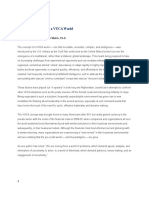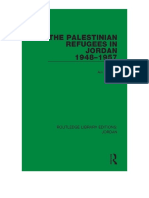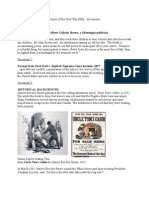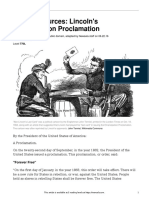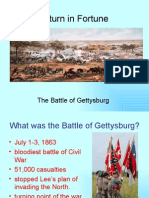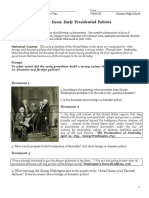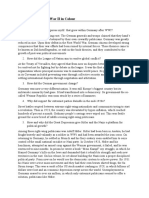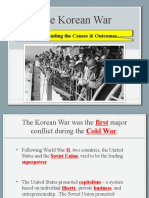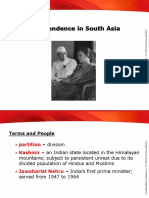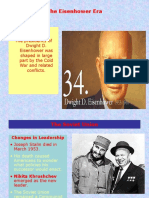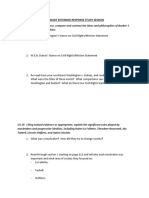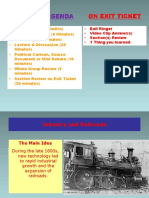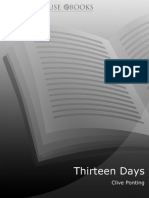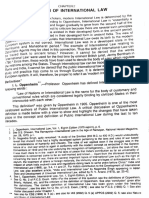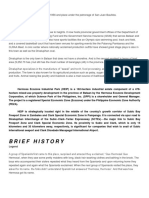0 ratings0% found this document useful (0 votes)
600 views25-3 The Second Red Scare
25-3 The Second Red Scare
Uploaded by
api-261609166Following WWII, the US faced the challenge of helping veterans transition to civilian life. The GI Bill provided education, job training, loans, and unemployment benefits to assist veterans. Demand for consumer goods rose as veterans used the benefits to get an education, buy homes, and start families, fueling economic growth. However, tensions with the Soviet Union led to a second Red Scare amid fears of communism at home and abroad, including the Soviet detonation of an atomic bomb and Mao's rise to power in China. These tensions erupted into war when North Korea invaded South Korea in 1950, drawing the US into the Korean War as part of a UN coalition to defend South Korea against communist aggression.
Copyright:
© All Rights Reserved
Available Formats
Download as PPT, PDF, TXT or read online from Scribd
25-3 The Second Red Scare
25-3 The Second Red Scare
Uploaded by
api-2616091660 ratings0% found this document useful (0 votes)
600 views29 pagesFollowing WWII, the US faced the challenge of helping veterans transition to civilian life. The GI Bill provided education, job training, loans, and unemployment benefits to assist veterans. Demand for consumer goods rose as veterans used the benefits to get an education, buy homes, and start families, fueling economic growth. However, tensions with the Soviet Union led to a second Red Scare amid fears of communism at home and abroad, including the Soviet detonation of an atomic bomb and Mao's rise to power in China. These tensions erupted into war when North Korea invaded South Korea in 1950, drawing the US into the Korean War as part of a UN coalition to defend South Korea against communist aggression.
Original Title
25-3 the second red scare
Copyright
© © All Rights Reserved
Available Formats
PPT, PDF, TXT or read online from Scribd
Share this document
Did you find this document useful?
Is this content inappropriate?
Following WWII, the US faced the challenge of helping veterans transition to civilian life. The GI Bill provided education, job training, loans, and unemployment benefits to assist veterans. Demand for consumer goods rose as veterans used the benefits to get an education, buy homes, and start families, fueling economic growth. However, tensions with the Soviet Union led to a second Red Scare amid fears of communism at home and abroad, including the Soviet detonation of an atomic bomb and Mao's rise to power in China. These tensions erupted into war when North Korea invaded South Korea in 1950, drawing the US into the Korean War as part of a UN coalition to defend South Korea against communist aggression.
Copyright:
© All Rights Reserved
Available Formats
Download as PPT, PDF, TXT or read online from Scribd
Download as ppt, pdf, or txt
0 ratings0% found this document useful (0 votes)
600 views29 pages25-3 The Second Red Scare
25-3 The Second Red Scare
Uploaded by
api-261609166Following WWII, the US faced the challenge of helping veterans transition to civilian life. The GI Bill provided education, job training, loans, and unemployment benefits to assist veterans. Demand for consumer goods rose as veterans used the benefits to get an education, buy homes, and start families, fueling economic growth. However, tensions with the Soviet Union led to a second Red Scare amid fears of communism at home and abroad, including the Soviet detonation of an atomic bomb and Mao's rise to power in China. These tensions erupted into war when North Korea invaded South Korea in 1950, drawing the US into the Korean War as part of a UN coalition to defend South Korea against communist aggression.
Copyright:
© All Rights Reserved
Available Formats
Download as PPT, PDF, TXT or read online from Scribd
Download as ppt, pdf, or txt
You are on page 1of 29
Healing the Wounds of War
Lesson 25-2
The Main Idea
Following the end of
World War II, U.S.
military forces—and
the rest of the
country—faced the
challenge of returning
to life during
peacetime.
Life in America after World War II
• The Servicemen’s Readjustment Act of 1944 was
better known as the GI Bill.
The GI Bill • The bill helped veterans transition to civilian life.
– Provided money for vets to attend college or receive
advanced job training
– Helped arrange for home, farm, or business loans
– Provided help in finding work as well as a year’s
worth of unemployment benefits
• Demand for consumer goods rose sharply.
• Returning vets built houses, which increased the
Increased demand for furniture and appliances.
Demand • A baby boom began as Americans began having
families.
Trying to Build a Better World
Human Rights Trade and Economic
Development
• The United Nations was created
following WWII. • At a conference in New
Hampshire, leaders agreed to
• In December 1948, the create the World Bank and the
commission presented the International Monetary
Universal Declaration of Fund.
Human Rights.
• The World Bank provided loans
• It declared that all human beings and grants to countries for the
are born free and equal. purpose of reducing poverty.
• It called for an end to slavery,
torture, and inhumane
punishment.
1948 Presidential Election
• It demanded a variety of civil
rights, including the right to • Truman’s popularity was low
assembly and the right to access and critics didn’t think he
the courts.
could win the election.
• It stated that elementary
education should be free and • Truman won the election.
available to all.
• Truman put forward his Fair
Deal program.
The Second Red Scare
The Main Idea
The start of the Cold War and events at home helped
trigger a second Red Scare in the late 1940s and early
1950s.
The Growing Fear of Communism
Soviet Atomic Weapons Communist China
• In September 1949 Truman • Communists in China had gained
announced that the Soviet nearly full control of the country.
Union had detonated an
atomic bomb. • The Nationalist government of
Chiang Kai-shek fled to Taiwan
• This was a shock to the
nation • China was in the hands of the
Communist Party under the
leadership of Mao Zedong.
• Americans worried that China
increased the Communist threat to
the United States.
Communism in the United States
• The House Un-American Activities Committee
investigated the full range of radical groups in the United
States, including Fascists and Communists.
• Truman created a plan to investigate all federal
employees. Those found to be disloyal to the United
States were barred from federal employment.
• The Smith Act made it a crime to call for the overthrow of
the U.S. government or belong to an organization that did
so.
• The McCarran Act limited the rights of Communist
organizations.
• Several spy cases in the late 1940s fueled fears of
communism.
Fighting Communism at Home
• The House Un-American Activities
Committee (HUAC) explored the
possible Communist influence in
Investigating
the American film industry.
Communism
• The Hollywood Ten refused to
answer HUAC questions about their
beliefs or those of their colleagues.
• Many others in Hollywood did
testify, for if they didn’t their
names were placed on a blacklist.
Fighting Communism at Home
The McCarran Act
• This act required Communist
organizations to register with the
government.
• It established a special board to
investigate Communist involvement.
• Made it illegal to plan a totalitarian
dictatorship
• Prevented Communists from entering
the United States
Spy Cases
• Alger Hiss—convicted of
being a spy for the
Soviets
• Klaus Fuchs—a
Manhattan Project
scientist who gave
atomic bomb information
to the Soviets
• Ethel and Julius
Rosenberg—
convicted of passing
secrets to the Soviets
and executed
Joseph McCarthy and the Second Red Scare
• Joseph McCarthy was a
senator who claimed
that there were 205
known Communists
working for the U.S.
Department of State.
• A political cartoonist
dubbed McCarthy’s
tactic of spreading fear
and making baseless
charges
McCarthyism.
• McCarthyism spread
beyond the Senate
into other branches of
government, into
universities, into labor
unions, and into
private businesses.
McCarthy’s Fall
McCarthy continued his campaign from the Senate but
became increasingly wild in his accusations.
In 1952 he began to go after fellow Republicans.
In 1954 he attacked the U.S. Army, claiming that it was
protecting Communists.
The public came to view McCarthy’s tactics as unfair.
The fear of communism remained, but Senator McCarthy
and McCarthyism faded away.
The Korean War
The Main Idea
Cold War tensions finally
erupted in a shooting war
in 1950. The United
States confronted a
difficult challenge
defending freedom
halfway around the
world.
Korea before the War
After World War II, Japanese-occupied Korea was
temporarily divided into northern and southern parts.
The Soviet Union controlled Korea north of the 38th
parallel. The United States would be in charge of Korea
south of the 38th parallel.
The Soviet Union established a communist government in
North Korea. North Korea called itself the Democratic
People’s Republic of Korea. Its first leader was Kim Il
Sung.
In South Korea, the United States promoted a democratic
system. The Republic of Korea was led by president
Syngman Rhee.
The Start of the Korean War
• North Korea invaded South Korea on
June 25, 1950.
• Most leaders in the United States were
surprised by this attack.
– American troops stationed in South
Korea since WW II had recently
completed their withdrawal.
– The United States was not well prepared
to fight in Korea; however, the decision
to fight was made quickly.
• Truman decided that the United States
would take a stand against Communist
aggression in Korea.
• The United Nations Security Council
voted unanimously in favor of the use
of force in Korea.
The Start of the Korean War
Role of the United Role of the United
States Nations
• South Korea was where • The UN Security Council
the United States had to supported the use of
take a stand against force in Korea.
Communist aggression.
• Truman sent ground
• Truman ordered troops to Korea.
American naval and air
forces to support Korean • The troops sent to Korea
ground troops. were to be a United
Nations force.
• Truman asked the
United Nations to • Instead of calling this a
approve the use of force war, the whole effort
to stop the North was referred to as a UN
Korean invasion. police action.
Combat in the Korean War
• UN forces made an amphibious landing behind North
Korean lines at the port city of Inchon.
The Inchon • MacArthur’s surprise attack worked beautifully.
Landing
• The September 1950 invasion at Inchon was a key
victory for UN forces.
• Offensives from Inchon and Pusan resulted in the
destruction or surrender of huge numbers of North
North Korea Korean troops.
on the Run
• By October 1950 all of South Korea was back in UN
hands.
• UN forces had begun to move into North Korea, but the
UN Forces when 260,000 Chinese troops joined the North Koreans
the UN began to retreat.
Retreat
• UN forces retreated all the way back to Seoul. It was
the longest fallback in U.S. military history.
General MacArthur Is Fired
• MacArthur said that the UN faced a
choice between defeat by the
Chinese or a major war with them.
• He wanted to expand the war by
bombing the Chinese mainland,
perhaps even with atomic weapons.
• Lieutenant General Matthew Ridgway
stopped the Chinese onslaught and
pushed them back to the 38th
parallel—without needing to expand
the war or use atomic weapons.
• MacArthur disagreed with President
Truman about the direction of the
fighting and challenged the authority
of the president.
• Truman fired MacArthur.
• Many Americans were outraged at
the firing of MacArthur.
Fighting Ends in Korea
Negotiating for Peace Events of 1953
• In July 1951 peace talks • In 1952 Dwight D.
began. Eisenhower—who promised to
end the war—was elected
• One major obstacle was the president.
location of the boundary
between the Koreas. • Fighting remained deadly—in
the final two months of the
• Meanwhile battles such as war, UN forces lost 57,000
Bloody Ridge and Heartbreak men and the Communists lost
Ridge continued, inflicting 100,000.
heavy casualties on both
sides. • An armistice agreement was
finally reached on July 27,
• In October 1951 peace talks 1953.
stalled over prisoners of war.
• The Korean War left the map
• Negotiators in Panmunjom of Korea looking much as it
continued to argue over the had in 1950.
details of a peace agreement
throughout 1952. • The human costs were huge.
You might also like
- Honest HistoryDocument68 pagesHonest HistoryMagda Crs100% (2)
- Living and Leading in A VUCA World - Thunderbird SchoolDocument4 pagesLiving and Leading in A VUCA World - Thunderbird SchoolPetra Fejes100% (2)
- Chapter 38 Outline APUSHDocument5 pagesChapter 38 Outline APUSHSteven Truong100% (1)
- Slavery Civil War Reconstruction - The Generals of The Civil War 870lDocument2 pagesSlavery Civil War Reconstruction - The Generals of The Civil War 870lapi-2996364990% (2)
- Liberty TreeDocument36 pagesLiberty Treeapi-285845974No ratings yet
- Hans Rudolf Vaget - 2008 - Thomas Mann's The Magic Mountain. A Case Book PDFDocument277 pagesHans Rudolf Vaget - 2008 - Thomas Mann's The Magic Mountain. A Case Book PDFIlGrandeOtreNo ratings yet
- 1636 - The Saxon Uprising-ARC - Eric FlintDocument253 pages1636 - The Saxon Uprising-ARC - Eric FlintKody Chou Law100% (1)
- The Palestinian Refugees in Jordan 1948-1957 - Avi PlascovDocument261 pagesThe Palestinian Refugees in Jordan 1948-1957 - Avi PlascovMeralMaNo ratings yet
- Us Political Parties: 1776 To PresentDocument11 pagesUs Political Parties: 1776 To PresentJakeNo ratings yet
- Causes of The Civil WarDocument34 pagesCauses of The Civil Warapi-321559404No ratings yet
- Anish Goli - AMSCO 7.2 & 7.3 World War I Reading & G.O 20-21Document6 pagesAnish Goli - AMSCO 7.2 & 7.3 World War I Reading & G.O 20-21Anish gNo ratings yet
- The Civil War Ken BurnsDocument5 pagesThe Civil War Ken BurnsSean WilliamsNo ratings yet
- Webquest:The Effects of The Transcontinental RailroadDocument9 pagesWebquest:The Effects of The Transcontinental RailroadLara LandryNo ratings yet
- Lets Compare Houston and LamarDocument11 pagesLets Compare Houston and Lamarapi-233750615No ratings yet
- 1 7 - Stirrings of RebellionDocument22 pages1 7 - Stirrings of Rebellionapi-235395204No ratings yet
- The Bill of Rights DmsDocument3 pagesThe Bill of Rights Dmsapi-274356655No ratings yet
- Crowns and Mantles: The Ranks and Titles of CormyrDocument9 pagesCrowns and Mantles: The Ranks and Titles of CormyrRonaldo HenriqueNo ratings yet
- Coast Artillery Journal - Aug 1944Document100 pagesCoast Artillery Journal - Aug 1944CAP History Library100% (1)
- Beginning of The Cold WarDocument40 pagesBeginning of The Cold WarDávid OroszNo ratings yet
- The Atomic AgeDocument19 pagesThe Atomic AgeNirmit VasavadaNo ratings yet
- Mobilization On The Home Front - 25.1Document17 pagesMobilization On The Home Front - 25.1mrmcpheerhs100% (1)
- Take Time To Deliberate But When The Time For Action Arrives, Stop Thinking and Go In.Document35 pagesTake Time To Deliberate But When The Time For Action Arrives, Stop Thinking and Go In.Joshua WhiteNo ratings yet
- The Cold WarDocument19 pagesThe Cold Warapi-690086282No ratings yet
- American Home Front WWIIDocument49 pagesAmerican Home Front WWIIsteven_e_kleinNo ratings yet
- Thirteen Colonies and The British EmpireDocument61 pagesThirteen Colonies and The British EmpirePhilip PaulNo ratings yet
- The Cold WarDocument26 pagesThe Cold WarAlbertoNo ratings yet
- Bill of RightsDocument14 pagesBill of RightsUngas NakNo ratings yet
- Social Studies & History Subject For Middle School - 6th Grade - Ancient World History XL by SlidesgoDocument37 pagesSocial Studies & History Subject For Middle School - 6th Grade - Ancient World History XL by SlidesgoAtharva Vinod ShahaneNo ratings yet
- Chapter 21 The Furnace of Civil WarDocument4 pagesChapter 21 The Furnace of Civil WarMO___oNo ratings yet
- Civil War DBQDocument10 pagesCivil War DBQKevin Earlie100% (1)
- APUSH American Pageant Ch. 22 Review QuestionsDocument2 pagesAPUSH American Pageant Ch. 22 Review QuestionsNickNo ratings yet
- Primary Sources - Lincolns Emancipation Proclamation 770lDocument3 pagesPrimary Sources - Lincolns Emancipation Proclamation 770lapi-299636499No ratings yet
- A Turn in Fortune: The Battle of GettysburgDocument15 pagesA Turn in Fortune: The Battle of GettysburgJayson0% (1)
- The United States ExecutiveDocument4 pagesThe United States ExecutiveNisha ChhetryNo ratings yet
- The Red ScareDocument5 pagesThe Red ScareMr. Graham LongNo ratings yet
- Causes of Wwi - ImadunceDocument12 pagesCauses of Wwi - ImaduncekmsochaNo ratings yet
- Northern Reformers Dossiers - StudentDocument8 pagesNorthern Reformers Dossiers - Studentapi-2673413790% (1)
- GSE SS8H6.abcde LessonReconstructionDocument89 pagesGSE SS8H6.abcde LessonReconstructionAnthony HolleyNo ratings yet
- Cold War Timeline (APUSH)Document14 pagesCold War Timeline (APUSH)NatalieTianNo ratings yet
- To Play The Game, Click Here!: Template by Bill Arcuri, WCSDDocument67 pagesTo Play The Game, Click Here!: Template by Bill Arcuri, WCSDJayson100% (1)
- 1950s Culture-1Document30 pages1950s Culture-1jakaro dejong100% (2)
- 2 The Road To RevolutionDocument33 pages2 The Road To Revolutionapi-294843376No ratings yet
- APUSH American Pageant Ch. 11 Review QuestionsDocument1 pageAPUSH American Pageant Ch. 11 Review QuestionsNick100% (1)
- Vietnam War PresentationDocument107 pagesVietnam War PresentationI just wanna view this book, y'all suck100% (1)
- DBQ Early Presidential Policies 13Document9 pagesDBQ Early Presidential Policies 13zackNo ratings yet
- The Progressive MovementDocument55 pagesThe Progressive Movement284161100% (1)
- The American Civil War: A StorymapDocument14 pagesThe American Civil War: A Storymapca2michelle14100% (1)
- APUSH American Pageant Ch. 16 Review QuestionsDocument1 pageAPUSH American Pageant Ch. 16 Review QuestionsNickNo ratings yet
- The Cold WarDocument13 pagesThe Cold WarKamillaNo ratings yet
- Conflict in Indochina EssayDocument2 pagesConflict in Indochina Essayisabella RepoleNo ratings yet
- Cuba and The Cold WarDocument10 pagesCuba and The Cold WarKashish SharmaNo ratings yet
- Chapter 11 - The Triumphs and Travails of Jeffersonian RepublicDocument7 pagesChapter 11 - The Triumphs and Travails of Jeffersonian RepublicAndi MeyerNo ratings yet
- The Conditions That Enabled Dictators To Rise To Power in The Interwar PeriodDocument4 pagesThe Conditions That Enabled Dictators To Rise To Power in The Interwar PeriodAlark SharmaNo ratings yet
- Korean War PowerPointDocument20 pagesKorean War PowerPointThe Hitman HarringtonNo ratings yet
- Eoc Review Guided NotesDocument25 pagesEoc Review Guided Notesapi-328061525No ratings yet
- 5 Washington AdamsDocument41 pages5 Washington Adamsapi-294843376No ratings yet
- APUSH Chapter 34 NotesDocument6 pagesAPUSH Chapter 34 NotesphthysyllysmNo ratings yet
- What Is Cold War?Document8 pagesWhat Is Cold War?Divya RajeshwarNo ratings yet
- The Counterculture of The 1960sDocument3 pagesThe Counterculture of The 1960sChetanya Mundachali100% (1)
- Civil WarDocument101 pagesCivil Warapi-456005245No ratings yet
- Unit 4: A Nation Divided: Lesson 7: ReconstructionDocument22 pagesUnit 4: A Nation Divided: Lesson 7: Reconstructionmjohnsonhistory100% (1)
- APUSH Chapter 37 OutlineDocument6 pagesAPUSH Chapter 37 OutlinePartyboy97No ratings yet
- Ch.12 Outline Apush AmscoDocument6 pagesCh.12 Outline Apush AmscoJosh Morgan100% (2)
- APUSH WWII NotesDocument5 pagesAPUSH WWII NotesphthysyllysmNo ratings yet
- Early Republic - WashingtonDocument12 pagesEarly Republic - Washingtonapi-305127889No ratings yet
- Class Lecture Notes 28Document16 pagesClass Lecture Notes 28Kasem AhmedNo ratings yet
- Branches of Government Study GuideDocument2 pagesBranches of Government Study Guideapi-261609166No ratings yet
- Bill of RightsDocument28 pagesBill of Rightsapi-261609166No ratings yet
- Independence in AfricaDocument21 pagesIndependence in Africaapi-261609166No ratings yet
- LegislativeDocument40 pagesLegislativeapi-261609166No ratings yet
- Federalist PapersDocument26 pagesFederalist Papersapi-261609166No ratings yet
- Syllabus-Government TruettDocument2 pagesSyllabus-Government Truettapi-261609166No ratings yet
- Independence in South AsiaDocument20 pagesIndependence in South Asiaapi-261609166No ratings yet
- Kennedy and The Cold War 27-1Document20 pagesKennedy and The Cold War 27-1api-261609166No ratings yet
- 28-1 Fighting SegregationDocument29 pages28-1 Fighting Segregationapi-261609166No ratings yet
- TN Ready Extended Response Study Session 6Document1 pageTN Ready Extended Response Study Session 6api-261609166No ratings yet
- 26-1 The Eisenhower EraDocument14 pages26-1 The Eisenhower Eraapi-261609166No ratings yet
- Eoc Review Long - Just OkDocument77 pagesEoc Review Long - Just Okapi-261609166No ratings yet
- 26-1 The Eisenhower EraDocument35 pages26-1 The Eisenhower Eraapi-261609166No ratings yet
- Today'S Agenda: On Exit TicketDocument48 pagesToday'S Agenda: On Exit Ticketapi-261609166No ratings yet
- TN Ready Extended Response Study Session 1Document2 pagesTN Ready Extended Response Study Session 1api-261609166No ratings yet
- Flags During WwiiDocument1 pageFlags During Wwiiapi-261609166No ratings yet
- 1 Dictatorships in EuropeDocument18 pages1 Dictatorships in Europeapi-261609166No ratings yet
- 25-1 The Iron Curtain Falls On EuropeDocument19 pages25-1 The Iron Curtain Falls On Europeapi-261609166No ratings yet
- Theodore RooseveltDocument12 pagesTheodore Rooseveltapi-261609166No ratings yet
- 22-1 Launching The New DealDocument19 pages22-1 Launching The New Dealapi-261609166No ratings yet
- Top 10 ToughiesDocument23 pagesTop 10 Toughiesapi-261609166No ratings yet
- Today'S Agenda: On Exit TicketDocument31 pagesToday'S Agenda: On Exit Ticketapi-261609166No ratings yet
- Today'S Agenda: On Exit TicketDocument13 pagesToday'S Agenda: On Exit Ticketapi-261609166No ratings yet
- 20 Whole Chapter American Life ChangesDocument39 pages20 Whole Chapter American Life Changesapi-261609166No ratings yet
- 9 - Reforms - Political and SocialDocument17 pages9 - Reforms - Political and Socialapi-261609166No ratings yet
- Today'S Agenda: On Exit TicketDocument30 pagesToday'S Agenda: On Exit Ticketapi-261609166No ratings yet
- 1 - Reconstruction-Manifest DestinyDocument27 pages1 - Reconstruction-Manifest Destinyapi-261609166No ratings yet
- Alexander AddamDocument57 pagesAlexander AddamEyuael SolomonNo ratings yet
- Thirteen Days Countdown To The WarDocument279 pagesThirteen Days Countdown To The WarSenay LibuNo ratings yet
- Democracy in The PhilippinesDocument11 pagesDemocracy in The PhilippinesRazeenaGlangNo ratings yet
- Marvel MoviesDocument2 pagesMarvel Moviesunknownshadow38No ratings yet
- Guinea-Bissau: Part I: The Colonial ExperienceDocument16 pagesGuinea-Bissau: Part I: The Colonial ExperiencealexNo ratings yet
- Hotchkiss 13.2mm Machine Gun - Wiki2Document4 pagesHotchkiss 13.2mm Machine Gun - Wiki2blowmeasshole1911No ratings yet
- Vietnam, ASEAN, and The South China Sea: Unity or Diverseness?Document20 pagesVietnam, ASEAN, and The South China Sea: Unity or Diverseness?Keane RazielNo ratings yet
- Slovenia - Wikipedia Jan2011Document41 pagesSlovenia - Wikipedia Jan2011Slovenian Webclassroom Topic ResourcesNo ratings yet
- Chapter - 3Document36 pagesChapter - 3demullu reddiNo ratings yet
- Research Proposal Hist 348Document9 pagesResearch Proposal Hist 348Marize DreyerNo ratings yet
- Definition of International Law: Rules Period. Modern Not in Ne Ayana Can Back To Though Greece, Today, ModernDocument1 pageDefinition of International Law: Rules Period. Modern Not in Ne Ayana Can Back To Though Greece, Today, ModernAkshat YadavNo ratings yet
- SoapstoneDocument7 pagesSoapstoneapi-491394701No ratings yet
- Paper 1: Move To Global War Japanese Expansion in East AsiaDocument48 pagesPaper 1: Move To Global War Japanese Expansion in East AsiaEnriqueNo ratings yet
- Greater Orlando Aviation AuthorityDocument14 pagesGreater Orlando Aviation AuthoritycbethuyNo ratings yet
- The Fox Project, A ReappraisalDocument22 pagesThe Fox Project, A ReappraisalZemin OonNo ratings yet
- Francis Parker Yockey - The Enemy of EuropeDocument101 pagesFrancis Parker Yockey - The Enemy of EuropeDhHaqq B. Thulê0% (1)
- 15 Misquotes From The QuranDocument53 pages15 Misquotes From The QuranMhmd ElkurdiNo ratings yet
- American History TimelineDocument4 pagesAmerican History Timelinederkovamar9No ratings yet
- KasaysayanDocument12 pagesKasaysayanJoed RodriguezNo ratings yet
- Causes of The Separation of East PakistanDocument4 pagesCauses of The Separation of East Pakistansyeduop3510No ratings yet
- Scotland Under Her 01 Robe U of TDocument468 pagesScotland Under Her 01 Robe U of TDaniel Álvarez Malo100% (2)
- M01 Marvel Captain America Level 2Document6 pagesM01 Marvel Captain America Level 2AlexNo ratings yet
- Total War Warhammer II-steampunks Torrent - 1337xDocument2 pagesTotal War Warhammer II-steampunks Torrent - 1337xIngrutinNo ratings yet

